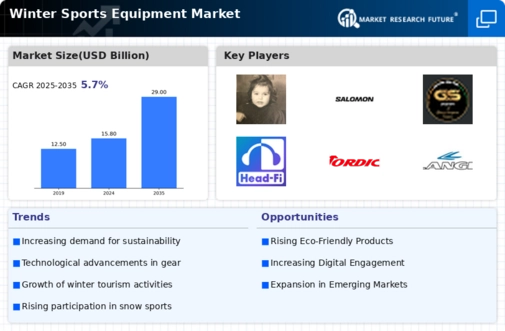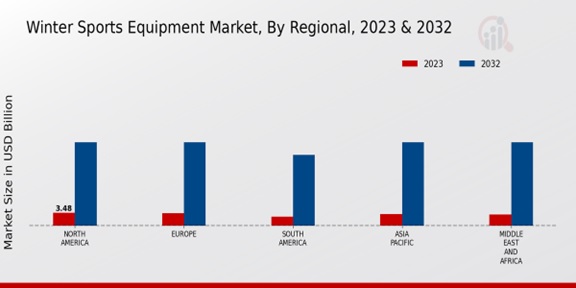Market Growth Projections
The Global Winter Sports Equipment Market Industry is poised for substantial growth, with projections indicating a market size of 15.8 USD Billion in 2024 and an anticipated increase to 29.0 USD Billion by 2035. This growth trajectory suggests a compound annual growth rate of 5.7% from 2025 to 2035. Such figures reflect the increasing consumer interest in winter sports and the ongoing innovations within the industry. The market's expansion is likely to be driven by factors such as rising participation rates, technological advancements, and growing tourism, all contributing to a vibrant and evolving landscape for winter sports equipment.
Rising Participation in Winter Sports
The Global Winter Sports Equipment Market Industry experiences a notable increase in participation rates in winter sports activities. This trend is driven by a growing interest in skiing, snowboarding, and ice skating among diverse demographics. For instance, the number of ski resorts worldwide has expanded, providing more access to winter sports. As a result, the market is projected to reach 15.8 USD Billion in 2024, reflecting the heightened enthusiasm for winter sports. This surge in participation not only boosts equipment sales but also encourages manufacturers to innovate and enhance product offerings, thereby contributing to the overall growth of the industry.
Technological Advancements in Equipment
Technological innovations play a pivotal role in shaping the Global Winter Sports Equipment Market Industry. Manufacturers are increasingly integrating advanced materials and smart technologies into their products, enhancing performance and safety. For example, the introduction of lightweight materials and improved binding systems in skis and snowboards has revolutionized user experience. Additionally, smart helmets equipped with communication systems and safety features are gaining traction. These advancements not only attract seasoned athletes but also appeal to beginners, thereby expanding the customer base. The ongoing investment in research and development is likely to propel the market towards a projected value of 29.0 USD Billion by 2035.
Growing Popularity of Winter Sports Tourism
The Global Winter Sports Equipment Market Industry benefits significantly from the rising popularity of winter sports tourism. Destinations known for skiing and snowboarding are witnessing increased tourist footfall, which in turn drives demand for winter sports equipment. Countries such as Switzerland, Canada, and Japan have become hotspots for winter sports enthusiasts, leading to a surge in rental services for equipment. This trend not only stimulates sales but also encourages local economies to invest in infrastructure and services catering to winter sports tourists. As the industry evolves, it is likely to see a compound annual growth rate of 5.7% from 2025 to 2035, further solidifying its market presence.
Increased Investment in Winter Sports Infrastructure
Investment in winter sports infrastructure is a crucial driver for the Global Winter Sports Equipment Market Industry. Governments and private entities are increasingly funding the development of ski resorts, snow parks, and related facilities. This investment not only enhances the overall experience for winter sports enthusiasts but also promotes accessibility. For instance, new ski lifts and improved snowmaking technologies are being implemented in various regions, making winter sports more appealing. Such developments are expected to contribute to the market's growth trajectory, with projections indicating a potential market size of 29.0 USD Billion by 2035, as more individuals engage in winter sports activities.
Environmental Awareness and Sustainability Initiatives
The Global Winter Sports Equipment Market Industry is witnessing a shift towards sustainability, driven by increasing environmental awareness among consumers. Manufacturers are responding by adopting eco-friendly practices and materials in their production processes. For example, some brands are utilizing recycled materials for ski and snowboard manufacturing, appealing to environmentally conscious consumers. This trend not only aligns with global sustainability goals but also enhances brand loyalty among customers. As the industry adapts to these changes, it is likely to see a rise in demand for sustainable products, further influencing market dynamics and contributing to its projected growth.






















Leave a Comment